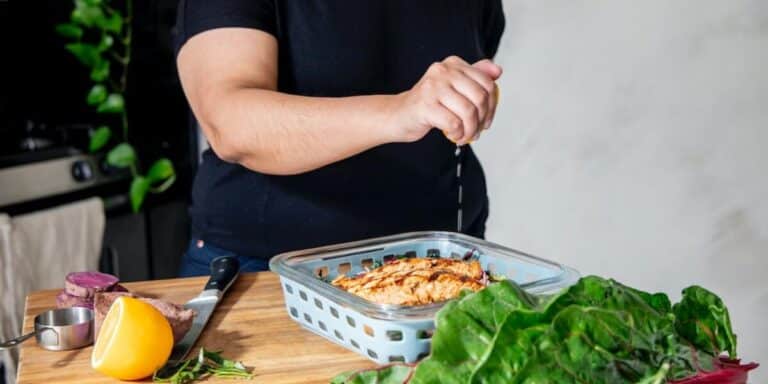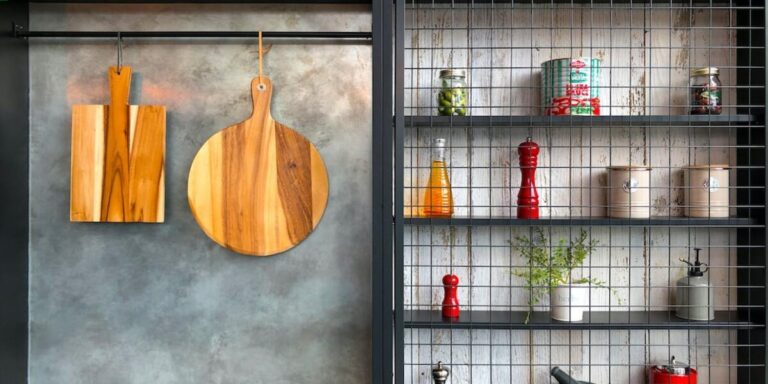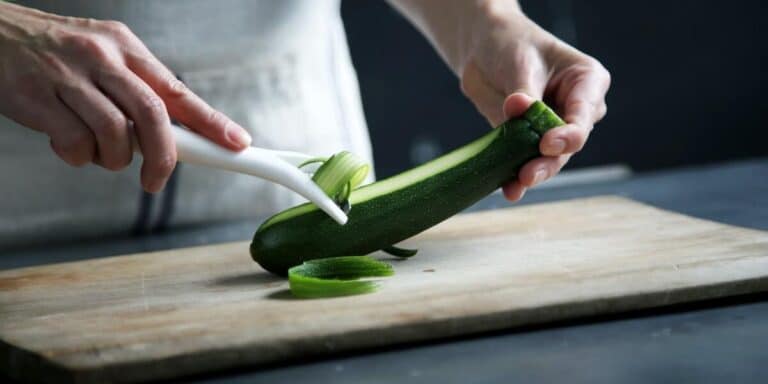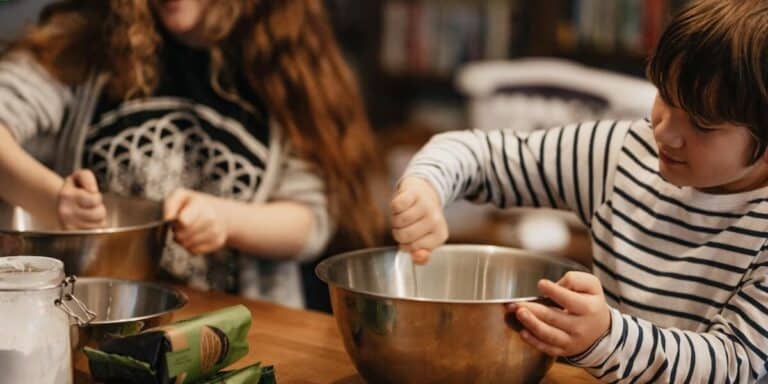Which Baking Sheet Is Best Non-Stick or Stainless Steel?
You’re probably familiar with the debate between non-stick and stainless steel baking sheets. If you’re like many home bakers, you’ve encountered the frustration of trying to remove stuck-on food from a baking sheet. Non-stick sheets seem like an easy solution, but you may have heard concerns about the durability of the coating. On the other hand, stainless steel sheets are known for their ruggedness, but you might be worried about food sticking to them. So, which type of baking sheet is best for you? The answer depends on several factors, including your cooking style and priorities.
Key Takeaways
• Non-stick baking sheets are ideal for delicate foods, easy cleaning, and low-maintenance, but may deteriorate over time and release toxic fumes.
• Stainless steel baking sheets are durable, resistant to scratches and corrosion, and safe for high-heat cooking, but may require seasoning for non-stick properties.
• Non-stick baking sheets require little to no oil for greasing, making them a healthier option, but may be prone to scratches and damage.
• Stainless steel baking sheets distribute heat evenly, reducing hotspots and inconsistent results, and are suitable for roasted foods.
• Consider your cooking needs and preferences: non-stick for easy release and cleaning, stainless steel for durability and heat distribution.
Non-Stick Baking Sheets Explained
Non-stick baking sheets are coated with a layer of material, usually PTFE (polytetrafluoroethylene) or a similar polymer, that prevents food from sticking to the surface, making food release and cleanup a breeze. You’ll find that this coating is typically applied to a metal substrate, such as aluminum or steel, which Provides The necessary durability and rigidity for the sheet. The non-stick coating is usually thin, ranging from 0.1 to 1.5 mils (0.0025 to 0.038 mm) in thickness, and is applied using various methods, including spraying, brushing, or rolling.
When you’re shopping for a non-stick baking sheet, you might come across different types of coatings, such as ceramic or silicone-based. These alternatives to PTFE are often marketed as more durable or heat-resistant, but it’s vital to acknowledge that they may not perform as well as PTFE from a non-stick perspective. You should also be aware that non-stick coatings can deteriorate over time, especially when exposed to high temperatures, metal utensils, or abrasive cleaners. To maintain the non-stick surface, it’s recommended to use gentle cleaning products, avoid metal scourers, and dry the sheet thoroughly after washing.
As you explore the world of non-stick baking sheets, you’ll encounter various brands and products with distinct features, such as reinforced coatings or textured surfaces. Understanding the basics of non-stick coatings and their characteristics will help you make an informed decision when selecting a baking sheet that suits your needs.
Benefits of Non-Stick Sheets
When you use a non-stick baking sheet, you’ll notice that food release is incredibly easy, making it a breeze to remove your freshly baked goods without them sticking or breaking apart. You’ll also appreciate how easy cleaning is, as a quick wipe with a damp cloth is often all you need to remove any residue. Additionally, you’ll find that you need to use less oil or cooking spray, which can make your baked goods healthier and less messy to handle.
Food Release Made Easy
With a non-stick baking sheet, you’ll have an easier time removing delicate foods like eggs, pancakes, and bread rolls, as they’ll release from the surface with minimal effort. You won’t have to worry about them sticking and breaking apart, which can be frustrating and wasteful. This is especially important when cooking with fragile ingredients, as you want to preserve their texture and presentation.
Non-stick baking sheets are also ideal for cooking foods with a high sugar content, such as cookies and pastries. Sugar can easily caramelize and stick to the surface, but with a non-stick sheet, you can remove your baked goods with ease. Additionally, you can cook foods at a lower temperature, reducing the risk of overcooking or burning.
Cleaning Is a Breeze
Cleaning a non-stick baking sheet is remarkably easy, as food residue doesn’t stick to the surface, making it a breeze to wipe down. You can simply use a soft sponge or cloth to remove any leftover food, and then give it a quick rinse with warm water. This means you’ll spend less time at the sink scrubbing away at stubborn stains, and more time enjoying your baked goods.
Because non-stick baking sheets are so easy to clean, you’ll be more likely to use them frequently, experimenting with new recipes and baking techniques. Plus, the non-stick coating helps prevent the buildup of bacteria and other microorganisms, keeping your baking sheet hygienic and safe to use. Overall, the ease of cleaning a non-stick baking sheet makes it a convenient and practical choice for home bakers. With a non-stick sheet, you can focus on the fun parts of baking, like creating delicious treats and sharing them with friends and family, rather than spending hours on cleanup.
Less Oil Required
Using a non-stick baking sheet reduces the amount of oil you need to grease the pan, making it a healthier option for baking. With a non-stick sheet, you’ll need little to no oil to prevent your baked goods from sticking. This is especially beneficial when baking delicate foods like meringues or macarons.
| Baking Sheet Type | Oil Required | Health Benefits |
|---|---|---|
| Non-Stick | Little to None | Healthier option, reduced calorie intake |
| Stainless Steel | Moderate to High | May lead to increased calorie intake |
| Aluminum | High | May lead to increased calorie intake |
| Silicone-Coated | Low | Healthier option, reduced calorie intake |
| Copper | Moderate | May lead to increased calorie intake |
Drawbacks of Non-Stick Sheets
Now that you’ve seen the benefits of non-stick sheets, it’s time to assess the potential downsides. You’ll want to think about how the non-stick coating holds up over time, whether heat distribution is even, and what chemical emissions might occur during use. As you weigh your options, these factors will help you decide if a non-stick baking sheet is the best choice for your needs.
Non-Stick Coating Wear
One major drawback of non-stick baking sheets is that their coating can wear off over time, especially if you expose them to high temperatures, metal utensils, or abrasive cleaners. You might notice that food starts to stick to the sheet more easily, or you might see scratches or flaking. This can be frustrating, especially if you’ve grown accustomed to the ease of a non-stick surface.
As you consider the durability of non-stick baking sheets, keep in mind the following factors that can contribute to coating wear:
- Temperature extremes: Avoid exposing your non-stick sheet to temperatures above 450°F (232°C) or below -20°F (-29°C), as this can cause the coating to break down.
- Metal utensils: Try to use silicone, wood, or plastic utensils instead of metal ones, which can scratch or chip the non-stick coating.
- Cleaning products: Choose gentle cleaners and avoid using abrasive materials or scouring pads, which can damage the coating and reduce its non-stick properties.
Heat Distribution Issues
Besides the risk of non-stick coating wear, you’ll also want to weigh another potential drawback of non-stick baking sheets: their tendency to distribute heat unevenly, which will affect the quality of your baked goods. You might notice hotspots on your non-stick baking sheets, where certain areas seem to brown more quickly than others. This can lead to inconsistent results, with some parts of your baked goods overcooked or undercooked. This issue is especially pronounced when baking delicate items like cookies or pastries, which require a high degree of temperature control.
You might find yourself constantly rotating your baking sheets or adjusting your oven temperature to compensate for these hotspots. This can be frustrating, especially if you’re trying to bake multiple items at once. In contrast, stainless steel baking sheets tend to distribute heat more evenly, reducing the risk of hotspots and inconsistent results. If you value consistency and precision in your baking, you might want to take stainless steel baking sheets into account as a more reliable option. By doing so, you’ll be able to achieve more uniform results and reduce the stress of constantly adjusting your baking technique.
Chemical Emissions Concerns
When you’re using non-stick baking sheets, you should be aware that the non-stick coating can release toxic fumes when heated to high temperatures, which can be a major concern for your health and safety. These fumes can cause polymer fume fever, a condition that’s characterized by flu-like symptoms such as headaches, fever, and body aches.
You should take precautions to minimize your exposure to these fumes. Here are three things you can do:
- Don’t overheat your non-stick baking sheets. Most non-stick coatings are safe up to 450°F (232°C), but it’s best to keep the temperature below 400°F (204°C) to be on the safe side.
- Use your exhaust fan. If you have an exhaust fan in your kitchen, use it when baking with non-stick sheets to help remove any fumes that may be released.
- Replace your non-stick sheets regularly. Over time, the non-stick coating can break down and release more fumes. Replacing your sheets regularly can help minimize your exposure to these fumes.
Stainless Steel Sheets Explained
Stainless steel baking sheets are a popular choice among bakers due to their durability and resistance to scratches, corrosion, and high temperatures. When you’re shopping for a stainless steel baking sheet, you’ll notice that they come in different gauges, which refer to the thickness of the metal. A lower gauge means a thicker metal, which is generally more durable and resistant to warping.
Here’s a comparison of different gauges and their characteristics:
| Gauge | Thickness | Characteristics |
|---|---|---|
| 18 | 1.27 mm | Thicker, more durable, and resistant to warping |
| 20 | 0.95 mm | Thinner, more prone to warping, but still durable |
| 22 | 0.71 mm | Thin, may warp easily, but still suitable for light use |
| 24 | 0.51 mm | Very thin, may warp or bend easily, not recommended |
| 26 | 0.40 mm | Extremely thin, not recommended for baking |
As you can see, the thickness of the metal can affect the performance of your baking sheet. A thicker metal will generally provide better results, but it may also be more expensive. When choosing a stainless steel baking sheet, consider your baking needs and the level of durability you require. If you’re a serious baker, a thicker metal may be worth the investment. However, if you’re a casual baker, a thinner metal may be sufficient.
Benefits of Stainless Steel Sheets
Offering a unique combination of durability and versatility, stainless steel baking sheets provide you with several benefits that can enhance your baking experience. One of the primary advantages of stainless steel sheets is their ability to withstand high temperatures, making them ideal for baking, roasting, and broiling. You can use them at high heat without worrying about damaging the sheet or releasing toxic fumes.
Another benefit of stainless steel baking sheets is their non-reactive nature. Unlike non-stick sheets, stainless steel sheets won’t react with acidic foods or transfer metallic flavors to your baked goods. This means you can bake a variety of foods, from sourdough bread to lemon bars, without affecting their taste or texture.
Here are just a few more benefits you can expect from stainless steel baking sheets:
- Easy cleaning: Stainless steel sheets are resistant to scratches and corrosion, making them easy to clean and maintain.
- Durable construction: Stainless steel sheets can withstand heavy use and last for years with proper care.
- Versatile: You can use stainless steel baking sheets for a wide range of tasks, from baking cookies to roasting vegetables.
Drawbacks of Stainless Steel Sheets
While stainless steel baking sheets come with many benefits, they also have some drawbacks that you should be aware of to guarantee you’re making an informed decision about which type of baking sheet is best for you. One of the major concerns is that they can be prone to scratches, especially if you use metal utensils or abrasive cleaners. These scratches can lead to the formation of rust spots, which can compromise the non-reactive properties of the stainless steel.
Another issue with stainless steel baking sheets is that they can be noisy. Whether you’re placing them in the oven or taking them out, they tend to make a clattering sound that might be annoying for some people. You should also be aware that stainless steel baking sheets can be quite heavy, which may make them difficult to handle for some users. This can be especially challenging when you’re trying to take them out of a hot oven.
Lastly, stainless steel baking sheets require more maintenance compared to non-stick baking sheets. You’ll need to clean them thoroughly after each use and dry them to prevent water spots. You might also need to season them periodically to maintain their non-stick properties. These extra maintenance tasks can be time-consuming and may deter some users from choosing stainless steel baking sheets.
Baking Sheet Material Comparison
When it comes to choosing the best baking sheet for your needs, comparing the materials is crucial, and you’ll want to weigh the key differences between non-stick and stainless steel options. You’re looking for a baking sheet that will make food release easy, cleanup a breeze, and cooking a joy.
Both non-stick and stainless steel baking sheets have their strengths and weaknesses. Non-stick sheets are great for delicate foods, such as eggs, pancakes, and cookies. Food release is effortless, and cleanup is a snap. However, non-stick sheets can be prone to scratches, and the coating may degrade over time, losing its non-stick properties.
On the other hand, stainless steel sheets are durable, resistant to scratches, and can withstand high temperatures. They’re perfect for roasted vegetables, meats, and breads. However, food can stick to them, making cleanup more challenging.
When deciding between non-stick and stainless steel, consider the following key factors:
- Type of cooking: If you’ll be cooking delicate foods frequently, a non-stick sheet might be the way to go. For roasted or high-heat cooking, stainless steel may be the better option.
- Ease of cleaning: If you value a hassle-free cleanup, non-stick sheets are the winner. But, if you’re willing to put in some elbow grease, stainless steel can be a great choice.
- Cooking temperature: If you’ll be cooking at extremely high temperatures, stainless steel is the safer bet, as non-stick coatings can degrade at high heat.
Durability and Longevity Matters
When it comes to durability and longevity, you want a baking sheet that can withstand regular use and cleaning. You’ll want to contemplate the thickness of the material, as it plays a significant role in determining the sheet’s overall lifespan and resistance to wear and tear. By choosing a baking sheet with a thicker, more durable material, you can expect it to perform well over time and provide you with years of reliable service.
Material Thickness Affects Longevity
The thickness of a baking sheet’s material plays a significant role in its durability and longevity, so it’s vital to contemplate this factor when choosing between non-stick and stainless steel options. You want a baking sheet that will withstand regular use and resist damage. A thicker material can provide better durability, but it also affects heat distribution and storage.
When considering material thickness, keep these points in mind:
- Thicker is not always better: While a thicker material may provide added durability, it can also make the baking sheet more prone to warping and less efficient at heat distribution.
- Material density matters: A denser material can provide better durability than a thicker, less dense one. Look for baking sheets made from high-quality, dense materials.
- Balance is key: Aim for a baking sheet with a balanced thickness that provides durability without compromising heat distribution or storage convenience.
Resistance to Wear Tear
Material thickness is just one aspect of a baking sheet’s durability; you also need to take into account its resistance to wear and tear, as a sheet that can withstand the rigors of regular use will ultimately provide more value. When it comes to resistance, non-stick baking sheets often fall short. Their coating can chip or flake off easily, especially if you’re using metal utensils or scrubbers to clean them. This can lead to rust and a decrease in non-stick performance over time.
On the other hand, stainless steel baking sheets are generally more resistant to wear and tear. They can withstand scratches and corrosion, and are less likely to warp or bend under high temperatures. However, they can be prone to sticking, especially if not seasoned properly. To get the most out of your stainless steel sheet, make sure to season it regularly and avoid using abrasive cleaners. By doing so, you’ll be able to enjoy your baking sheet for years to come, without worrying about it losing its performance. By choosing a durable baking sheet, you’ll be saving yourself the hassle and cost of frequent replacements.
Cleaning and Maintenance Tips
Keeping your baking sheet clean is just as essential as the baking process itself, so you’ll want to wash it after every use to prevent stubborn food residue from building up. You don’t want to be stuck with a baking sheet that’s caked with last week’s cookie crumbs when you’re trying to whip up a fresh batch.
When it comes to cleaning your baking sheet, you’ll want to use gentle techniques to avoid damaging the surface. For non-stick baking sheets, avoid using abrasive cleaners or scouring pads, as they can scratch the coating. Instead, opt for mild soap and water, and dry thoroughly after washing.
For stainless steel baking sheets, you can use a bit more elbow grease, but still be gentle.
- Avoid using metal utensils: Metal utensils can scratch or damage your baking sheet’s surface. Opt for silicone, wooden or plastic utensils instead.
- Don’t put your baking sheet in the dishwasher: The high heat and harsh detergents in the dishwasher can damage your baking sheet’s finish. It’s best to wash it by hand.
- Dry your baking sheet thoroughly after washing: Moisture can cause rust or water spots on your baking sheet. Make sure to dry it thoroughly after washing, paying extra attention to the crevices and corners.
Non-Stick Vs Stainless Steel Safety
When it comes to choosing between a non-stick and stainless steel baking sheet, safety considerations play a crucial role in your decision, as you’ll want to avoid potential health risks associated with chemical coatings or metal leaching.
With non-stick baking sheets, you’ll want to be aware of the potential for chemical coatings to break down over time, especially when exposed to high temperatures. Some non-stick coatings, like PFOA and PTFE, have been linked to health concerns, so selecting a non-stick baking sheet with a coating that’s PFOA-free and safe for high-heat use is of utmost importance.
Stainless steel baking sheets, on the other hand, are generally considered a safe choice, as they’re less likely to leach chemicals into your food. However, some stainless steel baking sheets may contain small amounts of nickel or chromium, which can be a concern for those with sensitivities.
Here’s a summary of the safety considerations for non-stick and stainless steel baking sheets:
| Baking Sheet Type | Safety Concerns | Recommendations |
|---|---|---|
| Non-Stick | Chemical coatings (PFOA, PTFE) | Choose PFOA-free coatings |
| Stainless Steel | Metal leaching (nickel, chromium) | Opt for nickel-free and chromium-free sheets |
| Non-Stick | Coating breakdown | Avoid high-heat use and metal utensils |
| Stainless Steel | Metal reactivity | Avoid cooking acidic or salty foods |
Ultimately, the safest choice between non-stick and stainless steel baking sheets will depend on your individual needs and preferences. By understanding the potential safety concerns and taking steps to mitigate them, you can enjoy safe and healthy cooking with your chosen baking sheet.
Heat Distribution and Conduction
When you’re baking, even heat distribution is vital for achieving perfectly cooked results. You’ll want a baking sheet that can efficiently transfer thermal energy, but the conductivity of non-stick and stainless steel materials varies substantially. Let’s explore how these materials affect heat distribution and conduction, and what methods can help you get the best results in the kitchen.
Conductivity of Materials
Because even heating is essential for perfectly baked goods, the conductivity of your baking sheet’s material plays a significant role in achieving this, with some materials distributing heat more efficiently than others. You want to choose a baking sheet that will allow for even heat distribution, so your baked goods cook consistently. When it comes to conductivity, you have a few options to think about.
Three key points to think about when evaluating the conductivity of baking sheet materials:
- Thermal conductivity: Measures how well a material can conduct heat. Materials with high thermal conductivity, like copper and aluminum, are great at distributing heat evenly.
- Density: Affects how well heat is transferred through the material. Less dense materials tend to be better at conducting heat.
- Thickness: Impacts how evenly heat is distributed. A thicker material can provide more even heat distribution, but may take longer to heat up.
Heat Distribution Methods
Your baking sheet’s heat distribution method can profoundly impact the quality of your baked goods, with the material’s ability to conduct heat and distribute it evenly being crucial for achieving perfectly cooked treats. You’ll want to take into account how your baking sheet’s material handles heat conduction and distribution. Non-stick baking sheets, typically made from aluminum or a non-stick coating on steel, are known for their even heat distribution. However, if the non-stick coating is damaged or of poor quality, hotspots can occur. Stainless steel baking sheets, on the other hand, tend to have a slightly less even heat distribution but retain heat exceptionally well, making them suitable for roasted foods.
As you decide which baking sheet is right for you, think about your baking style and preferences. If precise temperature control and even cooking are critical to your recipe, non-stick may be a good choice. However, stainless steel may be better if you frequently roast meats and vegetables that benefit from retained heat.
Thermal Energy Transfer
Across different baking sheets, thermal energy transfer varies substantially, with the efficiency of heat distribution and conduction playing a crucial role in determining the quality of your baked goods. When you’re baking, you want to make sure your sheet can distribute heat evenly, so your treats turn out perfectly cooked. You don’t want hotspots that’ll burn some areas while undercooking others.
You should consider how well a baking sheet conducts heat when making your selection. Three key factors that’ll impact thermal energy transfer are:
- Thickness: A thicker sheet will generally conduct heat more evenly, reducing hotspots and promoting consistent cooking.
- Material: Different materials have varying levels of thermal conductivity – for example, stainless steel is a good conductor, while non-stick coatings can be less effective.
- Finish: A smooth, even finish can also help with heat distribution, ensuring your baked goods cook consistently.
Food Release and Stickiness
When baking delicate foods like eggs, crepes, or sugar cookies, you’ll want a baking sheet that offers effortless food release to prevent sticking and messy cleanups. A non-stick baking sheet is generally the best choice for this task. Non-stick coatings, typically made from Teflon or ceramic, allow food to release easily, reducing the risk of breakage or deformation. This makes non-stick sheets ideal for baking delicate or fragile items that require gentle handling.
In contrast, stainless steel baking sheets can be sticky, especially when baking foods with high sugar or egg content. This stickiness can lead to messy cleanups and ruined baked goods. While some stainless steel sheets may claim to have a non-stick coating, these coatings can wear off over time, reducing their effectiveness.
However, it’s worth noting that non-stick baking sheets require more maintenance to preserve their non-stick properties. You’ll need to avoid using abrasive cleaners or scouring pads, which can damage the coating. Gentle hand washing and drying are recommended to safeguard the non-stick coating remains effective.
Ultimately, if food release and stickiness are top priorities for you, a non-stick baking sheet is likely the better choice. But if you’re willing to take extra precautions to prevent sticking on a stainless steel sheet, such as using parchment paper or a silicone mat, you can still achieve good results. The decision comes down to your specific baking needs and preferences.
Scratch Resistance and Wear
From the perspective of scratch resistance and wear, stainless steel baking sheets generally outperform non-stick sheets, as they can withstand metal utensils and abrasive cleaners without sustaining damage. You don’t have to worry about using a metal spatula or whisk with a stainless steel baking sheet, whereas non-stick sheets require gentle handling to prevent scratches. This durability also translates to longevity – stainless steel baking sheets can withstand the rigors of frequent use and cleaning without showing significant wear.
When evaluating the scratch resistance and wear of baking sheets, consider the following factors:
- Material thickness: A thicker baking sheet is less prone to scratches and warping. Look for stainless steel sheets with a thickness of at least 18-gauge (1.2 mm) for added durability.
- Finish: A brushed or satin finish on stainless steel baking sheets can help hide minor scratches, while a polished finish may show scratches more easily.
- Construction: Sheets with a reinforced rim or encased in a sturdy frame are less likely to warp or bend under stress, reducing the risk of scratches and wear.
Baking Sheet Care and Storage
Proper care and storage can extend the life of your baking sheet, whether you choose non-stick or stainless steel, so you’ll want to establish good habits to keep it performing at its best. When it comes to cleaning, you’ll want to avoid using abrasive materials or harsh chemicals, as they can damage the surface of your baking sheet. For non-stick baking sheets, a soft sponge and mild soap are usually sufficient. Stainless steel baking sheets, on the other hand, can withstand a bit more scrubbing power, but you’ll still want to avoid using steel wool.
After cleaning, drying your baking sheet thoroughly is crucial to prevent water spots. For non-stick baking sheets, this is especially important, as water spots can lead to the growth of bacteria and compromise the non-stick coating. You can dry your baking sheet with a towel or let it air dry. When storing your baking sheet, make sure to keep it in a dry, secure location where it won’t come into contact with other kitchen items that could scratch or damage it.
Choosing the Right Baking Sheet
Your baking needs and preferences play a significant role in determining whether a non-stick or stainless steel baking sheet is the better choice for you. Think about the types of baked goods you typically make, the frequency of use, and your desired level of ease in food release and cleaning.
When choosing a baking sheet, you should also weigh your cooking style. If you tend to cook delicate foods like fish or eggs, a non-stick baking sheet might be the better choice. However, if you frequently cook at high temperatures or make messy foods like roasted vegetables, a stainless steel baking sheet could be more suitable.
Three key factors to evaluate when selecting a baking sheet:
- Baking frequency and type: If you’re a frequent baker, a stainless steel baking sheet might be the better choice due to its durability and resistance to wear and tear. However, if you’re an occasional baker, a non-stick baking sheet might suffice.
- Desired level of non-stick surface: If you want a hassle-free baking experience with easy food release, a non-stick baking sheet is likely the better choice. However, if you don’t mind a bit more effort in food release, a stainless steel baking sheet can provide a more durable and long-lasting option.
- Budget and maintenance: Non-stick baking sheets tend to be less expensive than stainless steel baking sheets, but they may require more maintenance to maintain their non-stick coating.
Frequently Asked Questions
Are Non-Stick Baking Sheets Safe for Use at High Oven Temperatures?
"Over 60% of home bakers use non-stick baking sheets, but you might wonder, are they safe for high oven temperatures? Don’t worry, you can use them safely up to 450°F (232°C), but always check the manufacturer’s guidelines first."
Can Stainless Steel Baking Sheets Be Used for Serving Food Directly?
You can use stainless steel baking sheets to serve food directly, but you’ll want to make sure they’re clean and dry first. Plus, you might want to take into account the presentation, as they can look a bit industrial.
Do Baking Sheets Come With a Warranty or Guarantee?
You’re basically going to live forever with some baking sheets, because they’re so durable! But seriously, many brands do offer a warranty or guarantee, typically ranging from 1-5 years, so be sure to check the fine print.
Are Baking Sheets With a Non-Stick Coating Pfoa-Free?
You’re probably wondering if non-stick baking sheets are PFOA-free. Most modern non-stick coatings are PFOA-free, but you should still check the manufacturer’s label to confirm. It’s always a good idea to double-check to be safe.
Can Baking Sheets Be Used for Cooking Methods Other Than Baking?
You can use baking sheets for cooking methods other than baking, like roasting vegetables or cooking proteins in the oven. They’re also great for broiling, dehydrating, or even making homemade granola, giving you endless possibilities in the kitchen.





